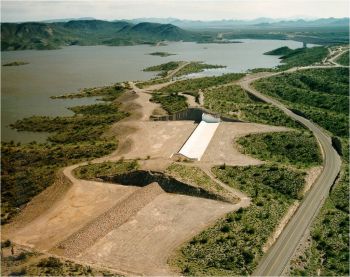Controlled Spillways: Difference between revisions
No edit summary |
No edit summary |
||
| (5 intermediate revisions by 3 users not shown) | |||
| Line 12: | Line 12: | ||
|caption= | |caption= | ||
<!-- Add picture caption --> | <!-- Add picture caption --> | ||
A fuseplug emergency spillway (bottom) at the New Waddell Dam. ([https://en.wikipedia.org/wiki/Fuse_plug Wikipedia]) | A fuseplug emergency spillway (bottom) at the New Waddell Dam. | ||
(Image Source: [https://en.wikipedia.org/wiki/Fuse_plug Wikipedia]) | |||
}} | }} | ||
“A controlled crest is one that includes gates which are used to control the flow; the uncontrolled crest is one unencumbered by gates”. <ref name="EM 1110-2-1603">[[Hydraulic Design of Spillways (EM 1110-2-1603) | EM 1110-2-1603 Hydraulic Design of Spillways, USACE, 1992]]</ref> “Controlled [[spillways]] include crest gates that serve as a movable damming surface allowing the spillway crest to be located below the normal operating level of a reservoir or channel”.<ref name="EM 1110-2-2702">[[Design of Spillway Tainter Gates (EM 1110-2-2702) | EM 1110-2-2702 Design of Spillway Tainter Gates, USACE, 2000]]</ref> | “A controlled crest is one that includes gates which are used to control the flow; the uncontrolled crest is one unencumbered by gates”. <ref name="EM 1110-2-1603">[[Hydraulic Design of Spillways (EM 1110-2-1603) | EM 1110-2-1603 Hydraulic Design of Spillways, USACE, 1992]]</ref> “Controlled [[spillways]] include crest gates that serve as a movable damming surface allowing the spillway crest to be located below the normal operating level of a reservoir or channel”.<ref name="EM 1110-2-2702">[[Design of Spillway Tainter Gates (EM 1110-2-2702) | EM 1110-2-2702 Design of Spillway Tainter Gates, USACE, 2000]]</ref> | ||
“For controlled spillways that are not integral with a concrete dam (i.e., located away from the dam on or through abutments, or on or through reservoir rim), existing topography must provide adequate space without excessive excavation. Also, the existing topography must allow appropriate orientation (alignment of the spillway between the reservoir and downstream river or stream) of the conveyance feature and terminal structure. Additionally, economics will come into play for all controlled spillways”.<ref name="DS14">[[Design Standards No. 14: Appurtenant Structures for Dams (Ch. 3: General Spillway Design Considerations) | Design Standards No. 14: Appurtenant Structures for Dams (Ch. 3: General Spillway Design Considerations), USBR, | “For controlled spillways that are not integral with a concrete dam (i.e., located away from the dam on or through abutments, or on or through reservoir rim), existing topography must provide adequate space without excessive excavation. Also, the existing topography must allow appropriate orientation (alignment of the spillway between the reservoir and downstream river or stream) of the conveyance feature and terminal structure. Additionally, economics will come into play for all controlled spillways”.<ref name="DS14">[[Design Standards No. 14: Appurtenant Structures for Dams (Ch. 3: General Spillway Design Considerations) | Design Standards No. 14: Appurtenant Structures for Dams (Ch. 3: General Spillway Design Considerations), USBR, 2022]]</ref> | ||
==Types of Controlled Spillways== | ==Types of Controlled Spillways== | ||
*[[Fuseplug Spillways]] | *[[Fuseplug Spillways]] | ||
*[[Fusegate Spillways]] | *[[Fusegate Spillways]] | ||
*[[Gated | *[[Gates/Bulkheads|Gated Spillways]] | ||
*[[Siphon | *[[Siphon Spillways]] | ||
==Best Practices Resources== | <noautolinks>==Best Practices Resources==</noautolinks> | ||
{{Document Icon}} [[Design Standards No. 14: Appurtenant Structures for Dams (Ch. 3: General Spillway Design Considerations) | Design Standards No. 14: Appurtenant Structures for Dams (Ch. 3: General Spillway Design Considerations), USBR]] | |||
{{Document Icon}} [[Design Standards No. 14: Appurtenant Structures for Dams (Ch. 3: General Spillway Design Considerations)|Design Standards No. 14: Appurtenant Structures for Dams (Ch. 3: General Spillway Design Considerations) ( | {{Document Icon}} [[Design of Spillway Tainter Gates (EM 1110-2-2702) | Design of Spillway Tainter Gates (EM 1110-2-2702), USACE]] | ||
{{Document Icon}} [[Hydraulic Design of Spillways (EM 1110-2-1603)]] | {{Document Icon}} [[Hydraulic Design of Spillways (EM 1110-2-1603) | Hydraulic Design of Spillways (EM 1110-2-1603), USACE]] | ||
<!-- For information on notation for in text citations visit https://www.mediawiki.org/wiki/Help:Cite Or simply enclose the citation as shown <ref> citation </ref> in the location of the in text mention. Citations will automatically populate below--> | <!-- For information on notation for in text citations visit https://www.mediawiki.org/wiki/Help:Cite Or simply enclose the citation as shown <ref> citation </ref> in the location of the in text mention. Citations will automatically populate below--> | ||
Latest revision as of 15:41, 25 July 2023

|
| A fuseplug emergency spillway (bottom) at the New Waddell Dam.
(Image Source: Wikipedia) |
“A controlled crest is one that includes gates which are used to control the flow; the uncontrolled crest is one unencumbered by gates”. [1] “Controlled spillways include crest gates that serve as a movable damming surface allowing the spillway crest to be located below the normal operating level of a reservoir or channel”.[2]
“For controlled spillways that are not integral with a concrete dam (i.e., located away from the dam on or through abutments, or on or through reservoir rim), existing topography must provide adequate space without excessive excavation. Also, the existing topography must allow appropriate orientation (alignment of the spillway between the reservoir and downstream river or stream) of the conveyance feature and terminal structure. Additionally, economics will come into play for all controlled spillways”.[3]
Types of Controlled Spillways
Best Practices Resources
![]() Design of Spillway Tainter Gates (EM 1110-2-2702), USACE
Design of Spillway Tainter Gates (EM 1110-2-2702), USACE
![]() Hydraulic Design of Spillways (EM 1110-2-1603), USACE
Hydraulic Design of Spillways (EM 1110-2-1603), USACE
Citations:
Revision ID: 7461
Revision Date: 07/25/2023
